A Russian-European team tested a new inflatable spacecraft over the weekend with the launch of their “Demonstrator-2” on board a converted Volna SS-N-18 intercontinental ballistic missile. The prototype was less than a metre across when packed into the rocket, but it inflated into a sail almost 4 metres across when it reached orbit. It then drifted back to Earth somewhere near the Kamchatka Peninsula. Future uses for this technology could include a method for bailing out of the space station, or to transfer cargo from space back to Earth.
ESA Agrees to Begin Venus Express
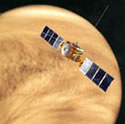
Image credit: ESA
The members of the European Space Agency agreed to start work on Venus Express, which will reuse the Mars Express spacecraft design. It will also reuse several instruments from both Mars Express and Rosetta to peer through our twin planet Venus’ thick clouds. One country, Italy, still has until October 2002 to confirm its participation in the payload. If all goes well, the spacecraft will launch in 2005.
On 11 July 2002, Europe took a step closer to Venus. The ESA Science Programme Committee agreed unanimously to start work on Venus Express. Venus Express will reuse the Mars Express spacecraft design and needs to be ready for launch in 2005.
The mission’s fate is not yet final because one nation, Italy, has still to confirm its participation in the payload. Italy has been given until 15 October 2002 to provide its final commitment.
The idea behind Venus Express began in 2001 when ESA issued a call for ideas to reuse the Mars Express spacecraft design for a quick, low-cost mission. Among the constraints were that the new mission had to use the industrial teams already in place for Mars Express and that meant double-quick development. Despite the constraints, a large number of good ideas came in from scientists around Europe. Venus Express was eventually selected because of its great scientific value. Venus is not well explored and an excellent group of instruments were easily available in Europe. These instruments had been developed as back-ups for either ESA’s Mars Express spacecraft or ESA’s comet-chaser mission, Rosetta. The instrument suite will be able to look at the planetary environment from surface to outermost atmosphere.
In November 2001, ministers from ESA’s Member States restricted the ESA Science Directorate’s budget thereby reducing the chance of survival of the Venus Express proposal.
Nevertheless, against the odds, Venus Express appeared among the missions proposed in the restructured programme presented to the Science Programme Committee in May 2002. However, at the last moment, the Director of Science withdrew it from consideration because he felt that the Member States and the scientists were not fully able to commit to providing funds and instruments within the tight schedule required.
The Director of Science, Prof. David Southwood remembers, “I did not like withdrawing it from our plans but it was better not to start at all than to have to stop badly later.”
In June 2002, the ESA Council heard Southwood’s report. The Council Chairman, Alain Bensoussan of France, strongly urged a re-evaluation of the viability of the Venus Express. On 11 July 2002, the SPC decided the prospects were now sound enough to commence work to meet a launch date in November 2005 that is fixed by the motion of the heavens.
“The Venus Express mission has now taken a big step towards realisation. However, there is much work to do and we had to demand everyone has to be ready if it is to fly in time,” Southwood says, adding, “I’m now glad to see that the Cosmic Vision programme moves closer to its original shape. If we can get Venus Express confirmed in the autumn, ESA will be the only space agency in the world with current plans to visit each planet in the inner Solar System.”
Original Source: ESA News Release
NASA Grounds Shuttle Fleet
NASA controllers grounded the shuttle fleet for at least two more months on Friday after they discovered small fuel line cracks – so far they’ve uncovered 11 in the four shuttles. All the cracks are very small, only a few millimetres in length, but NASA is worried that a piece of metal could chip off the fuel line and fall into a main engine during liftoff. This could have disastrous results. Two shuttle flights are currently on hold until the problem can be fixed.
Hubble Spots a Star’s Finale
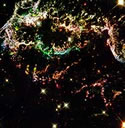
Image credit: Hubble
The newest image release from the Hubble Space Telescope is of the shredded remnants of Cassiopeia A, a star that went supernova more than 10,000 years ago – the youngest known supernova in our galaxy. Debris has formed into thousands of cooling knots of gas and dust, and will eventually supply new star systems with heavier elements such as oxygen and sulphur.
Glowing gaseous streamers of red, white, and blue ? as well as green and pink ? illuminate the heavens like Fourth of July fireworks. The colorful streamers that float across the sky in this photo taken by NASA’s Hubble Space Telescope were created by one of the biggest firecrackers seen to go off in our galaxy in recorded history, the titanic supernova explosion of a massive star. The light from the exploding star reached Earth 320 years ago, nearly a century before our United States celebrated its birth with a bang.
The dead star’s shredded remains are called Cassiopeia A, or “Cas A” for short. Cas A is the youngest known supernova remnant in our Milky Way Galaxy and resides 10,000 light-years away in the constellation Cassiopeia, so the star actually blew up 10,000 years before the light reached Earth in the late 1600s.
This stunning Hubble image of Cas A is allowing astronomers to study the supernova’s remains with great clarity, showing for the first time that the debris is arranged into thousands of small, cooling knots of gas. This material eventually will be recycled into building new generations of stars and planets. Our own Sun and planets are constructed from the debris of supernovae that exploded billions of years ago.
This photo shows the upper rim of the supernova remnant’s expanding shell. Near the top of the image are dozens of tiny clumps of matter. Each small clump, originally just a small fragment of the star, is tens of times larger than the diameter of our solar system.
The colors highlight parts of the debris where chemical elements are glowing. The dark blue fragments, for example, are richest in oxygen; the red material is rich in sulfur.
The star that created this colorful show was a big one, about 15 to 25 times more massive than our Sun. Massive stars like the one that created Cas A have short lives. They use up their supply of nuclear fuel in tens of millions of years, 1,000 times faster than our Sun. With their fuel exhausted, heavy stars begin a complex chain of events that lead to the final dramatic explosion. Their cores rapidly collapse, releasing an enormous amount of gravitational energy. This sudden burst of energy reverses the collapse and tosses most of the star’s mass into space. The ejected material can travel as fast as 45 million miles per hour (72 million kilometers per hour).
The images were taken with the Wide Field and Planetary Camera 2 in January 2000 and January 2002.
Original Source: Hubble News Release
Station Crew Unload Progress Cargo
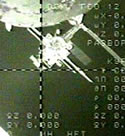
Image credit: NASA
The crew of the International Space Station spent a busy day on Friday unloading the cargo delivered by the latest Progress 8 supply ship. The automated ship was launched from the Baikonur Cosmodrome on board a Soyuz rocket on June 26, and it docked three days later.
Crewmembers aboard the International Space Station today continued to unload the Progress 8 unpiloted Russian cargo carrier docked to the aft port of the station?s Zvezda Service Module. Meanwhile, activities in the U.S. laboratory Destiny focused on initial setup of the SUBSA (Solidification Using a Baffle in Sealed Ampoules) experiment in the lab?s new Microgravity Science Glovebox (MSG).
Expedition 5 Commander Valery Korzun, and Flight Engineers Peggy Whitson and Sergei Treschev had a relatively light week of work; with Sunday and Monday largely rest days after last Saturday?s docking of the Progress 8. July 4 was essentially a holiday in space for the crewmembers, thought they did some work off a generic task list.
Whitson spent much of this morning installing the SUBSA experiment in the glovebox, which has not yet been commissioned for operations. The SUBSA installation will be completed once the MSG is activated.
Earlier this week, crewmembers began unloading the Progress and cataloguing its contents into the computerized, barcode Inventory Management System of the space station. Whitson brought the Medium-rate Communications Outage Recorder (MCOR) in Destiny back to life on Wednesday, after a three-week outage. She checked its fans and replaced a computer docking station. The MCOR records payload data during periods when the station is out of communication with the ground and transmits the data once communications are restored. The outage had no impact on science operations.
Next Wednesday, Korzun and Whitson will be at the controls of the Canadarm2 robotic arm in Destiny, commanding the Canadian-built arm to ?walk off? its grapple fixture on the laboratory so that its available latching end effector can grapple a power and data fixture on the recently installed Mobile Base System, the platform mounted on the station?s rail car on the S0 (S-Zero) truss. One end of the arm is already affixed to the Mobile Base System, but the ?walk off? of the other end of the arm to the mobile platform will mark another first for station robotic operations. The rail car will eventually move down the truss to be placed in position for the installation of the S1 Truss on the starboard side of the ISS, planned for later this year.
U.S. and Russian timeliners have converged on Aug. 16 and 23 as the two dates for spacewalks planned by Korzun and Whitson, then Korzun and Treschev, to mount experiments on the outside of the station and to install micrometeoroid debris shields on Zvezda. Those are the only two spacewalks planned for the Expedition 5 crew.
Original Source: NASA News Release
Ariane 5 Rocket Launches Two Satellites
A powerful Ariane 5 rocket lifted off late Friday from the European Space Agency (ESA) launch center in Kourou, French Guiana. It was carrying two satellites: the STELLAT 5 which will provide Internet and video transmission to Europe, Africa and the Middle East; and the N-STAR C which will support mobile phones in Japan. This is the 12th launch of an Ariane 5.
Russians Propose Human Mars Mission
Russian space officials have announced their intentions to send human explorers to Mars by 2015. Hoping for International support to help fund the $20 billion budget, managers have already planned out the mission basics. They’re estimating that two ships would travel to Mars and deliver three people to the surface for 440 days while three others would remain in orbit. Obviously this is completely preliminary in nature, and officials from NASA or the ESA have yet to comment if they would support this Russian initiative.
CONTOUR Comet Mission Launches
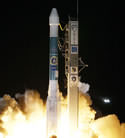
Image credit: NASA
NASA’s Comet Nucleus Tour (CONTOUR) spacecraft launched successfully on board a Boeing Delta II rocket this week. Designed by the John Hopkins University Applied Physics Laboratory, the 970 kilogram spacecraft was placed into an elliptical orbit 63 minutes after launch. CONTOUR will orbit Earth until August 15, when it will fire its main engine and begin chasing Comets Encke and Schwassmann-Wachmann 3. If all goes as planned, the spacecraft will get as close as 100km from each comet’s nucleus.
NASA?s Comet Nucleus Tour (CONTOUR) spacecraft ? set to provide the closest look yet at the ?heart? of a comet?successfully launched today at 2:47 a.m. EDT aboard a Boeing Delta II rocket from Cape Canaveral Air Force Station, Fla.
Designed and built by The Johns Hopkins University Applied Physics Laboratory (APL) in Laurel, Md., the 2,138-pound (970-kilogram) spacecraft was placed into an elliptical Earth orbit 63 minutes after launch. About 19 minutes later the mission operations team at APL acquired a signal from the spacecraft through the Deep Space Network antenna station in Goldstone, Calif., and by 5:45 a.m. EDT Mission Director Dr. Robert W. Farquhar of the Applied Physics Lab confirmed the craft was operating normally and ready to carry out its early orbit maneuvers.
?CONTOUR?s launch was a spectacular start to an important project,? says Dr. Stamatios M. Krimigis, head of the APL Space Department. ?CONTOUR is next in the growing lineup of missions to explore small planetary bodies ? such as comets and asteroids ? and we expect it will add much to what little we know about these ancient samples of the solar system?s original materials.?
CONTOUR will orbit Earth until Aug. 15, when it?s scheduled to fire its main engine and enter a comet-chasing orbit around the sun. The mission?s flexible four-year plan includes encounters with comets Encke (Nov. 12, 2003) and Schwassmann-Wachmann 3 (June 19, 2006), though it can add an encounter with a ?new? and scientifically valuable comet from the outer solar system, should one be discovered in time for CONTOUR to fly past it. CONTOUR?s four scientific instruments will take detailed pictures and measure the chemical makeup of each comet?s nucleus ? a chunk of ice and rock ? while analyzing the surrounding gas and dust.
The 8-sided solar-powered craft will fly as close as 62 miles (100 kilometers) from each nucleus, protected by a 10-inch-thick, layered dust shield of heavy Nextel and Kevlar fabric. Scientists expect the data to reveal the differences between comet nuclei and answer questions about the role comets had in shaping the Earth and other planets.
?We?re looking forward to a fantastic mission,? says APL?s Edward L. Reynolds, who at launch assumed the role of CONTOUR project manager from Mary C. Chiu, who is retiring from the Applied Physics Laboratory. ?From mission design and operations at APL, to the navigation group at NASA?s Jet Propulsion Laboratory, to the science effort headed by Cornell University, this team includes the talent and expertise needed to capture and deliver the best data yet on a comet?s nucleus.?
The $159 million CONTOUR is the sixth mission in NASA?s Discovery Program of lower cost, scientifically focused exploration projects. APL manages the mission, built the spacecraft and its two cameras, and will operate CONTOUR during flight. NASA?s Goddard Space Flight Center, Greenbelt, Md., provided CONTOUR?s neutral gas/ion mass spectrometer and von Hoerner & Sulger, GmbH, Schwetzingen, Germany, built the dust analyzer. NASA?s Jet Propulsion Laboratory, Pasadena, Calif., will provide navigation and Deep Space Network (DSN) support. Dr. Joseph Veverka, CONTOUR?s principal investigator from Cornell University, Ithaca, N.Y., leads a science team of co-investigators from universities, industry and government agencies in the U.S. and Europe.
Original Source: NASA News Release
Chandra Finds a Bull’s Eye Pulsar
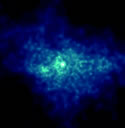
Image credit: Chandra
The newest image taken with the Chandra X-Ray Observatory is of distant supernova remnant SNR G54.1+0.3. The object contains a ring of high-energy particles which is created by a rapidly spinning central neutron star. Because it spins 7 times a second, the neutron star has created an enormous electric field which accelerates particles near the star and produces jets which blast away from the poles.
The Chandra image of the distant supernova remnant SNR G54.1+0.3 reveals a bright ring of high-energy particles with a central point-like source. This observation enabled scientists to use the giant Arecibo Radio Telescope to search for and locate the pulsar, or neutron star that powers the ring. The ring of particles and two jet-like structures appear to be due to the energetic flow of radiation and particles from the rapidly spinning neutron star rotating 7 times per second.
During the supernova event, the core of a massive star collapsed to form a neutron star that is highly magnetized and creates an enormous electric field as it rotates. The electric field accelerates particles near the neutron star and produces jets blasting away from the poles, and as a disk of matter and anti-matter flowing away from the equator at high speeds. As the equatorial flow rams into the particles and magnetic fields in the nebula, a shock wave forms. The shock wave boosts the particles to extremely high energies causing them to glow in X-rays and produce the bright ring (see inset).
The particles stream outward from the ring and the jets to supply the extended nebula, which spans approximately 6 light years.
The features observed in SNR G54.1+0.3 are very similar to other “pulsar wind nebulas” found by Chandra in the Crab Nebula, the Vela supernova remnant, and PSR B1509-58. By analyzing the similarities and differences between these objects, scientists hope to better understand the fascinating process of transforming the rotational energy of the neutron star into high-energy particles with very little frictional heat loss.
Original Source: Chandra News Release
Young Stars in an Old Galaxy
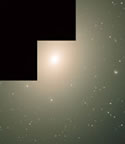
Image credit: Hubble
Astronomers have spotted a number of young stellar clusters dotted around a very old elliptical galaxy – this disputes the established theory that old galaxies contain only older stars. The team used the Hubble Space Telescope and the ESO Very Large Telescope to take a series of images of galaxy NGC 4365, and they were able to identify star clusters that were only a few billion years old, while the majority were over 12 billion years old. Why the galaxy contains such a combination of young and old stars is still a mystery.
Combining data from the NASA/ESA Hubble Space Telescope and the ESO Very Large Telescope (VLT), a group of European and American astronomers have made a major discovery. They have identified a huge number of ‘young’ stellar clusters, in an old elliptical galaxy.
For the first time, it has been possible to identify several distinct periods of star formation in a galaxy as old as this one. Elliptical galaxies have always been considered to have undergone one early star-forming period and thereafter to be devoid of star formation. However, the combination of the best and largest telescopes in space and on the ground has now clearly shown that there is more than meets the eye.
Do elliptical galaxies only contain old stars?
One of the challenges of modern astronomy is to understand how galaxies – large systems of stars, gas and dust – form and evolve. When did most of the stars in the Universe form? Did this happen at a very early stage, within a few billion years of the Big Bang? Have a significant number of the stars we now observe formed much more recently?
Spectacular collisions between galaxies take place all the time, triggering the formation of thousands or even millions of stars. However, when looking at the Universe as a whole, most of its stars are found in elliptical galaxies whose overall appearance has so far led us to believe that they, and their stars and as well, are old.
These elliptical galaxies do shine with the diffuse, reddish glow normally associated with stars that are many thousand million years old. However, what is the underlying mix of stars that produces this elderly appearance? Could a significant number of much younger stars be ‘hiding’ among the older ones?
Detailed observations with the world’s premier telescopes have now cast new light on this central question about the behaviour of some of the major building blocks of the Universe.
Cosmic paleonthology
To break the stellar ‘cocktail’ in elliptical galaxies down into its different constituents, a team of European and American astronomers observed massive stellar clusters in and around nearby galaxies. These “globular” clusters, so called because of their shape, exist in large numbers around all observed galaxies and form a kind of ‘skeleton’ within their host galaxies. These ‘bones’ receive an imprint for every episode of star formation they undergo. By reading the ages of the globular clusters in a galaxy, it is possible to identify the past epoch(s) of active star formation in a galaxy.
Reading the imprints and deducing the distribution of ages of the globular clusters, astronomers can reveal when many of the stars in elliptical galaxies formed. This is similar to the way a palaeontologist uses the skeletons of dinosaurs to deduce information about the era in which they lived.
A surprising discovery
The team combined images of a number of galaxies from Hubble’s Wide Field and Planetary Camera 2 with infrared images obtained from the multi-mode ISAAC instrument on the 8.2m VLT Antu telescope at the ESO Paranal Observatory (Chile). To their great surprise, they discovered that many of the globular clusters in one of these galaxies, NGC 4365, a member of the large Virgo cluster of galaxies, were only a few thousand million years old, much younger than most of the other stars in this galaxy (roughly 12 thousand million years old).
The astronomers were able to identify three major groups of stellar clusters. There is an old population of clusters of metal-poor stars, some clusters of old but metal-rich stars and now, seen for the first time, a population of clusters with young and metal-rich stars.
These results have been fully confirmed by spectroscopic observations made with another of the world’s giant telescopes, the 10-metre Keck on Hawaii.
“It is a great pleasure to see two projects wholly or partly funded by Europe – VLT and Hubble – work in concert to produce such an important scientific result”, says Piero Benvenuti, ESA Hubble Project Scientist. “The synergy between the most advanced ground and space telescopes continues to prove its effectiveness, paving the way to impressive new discoveries that would not otherwise be possible.”
The discovery of young globular clusters within old galaxies is surprising since the stars in the giant elliptical galaxies were until now believed to have formed during a single period early in the history of the Universe. It is now clear that some of the galaxies may be hiding their true nature and have indeed experienced much more recent periods of major star formation.
Original Source: ESA News Release
